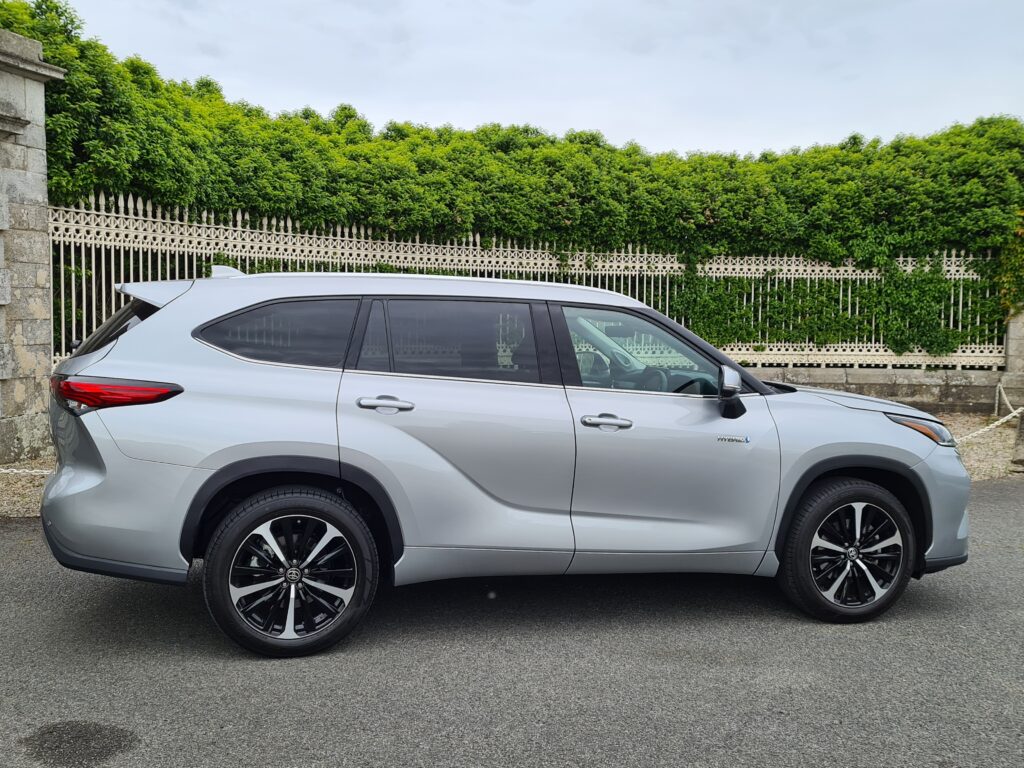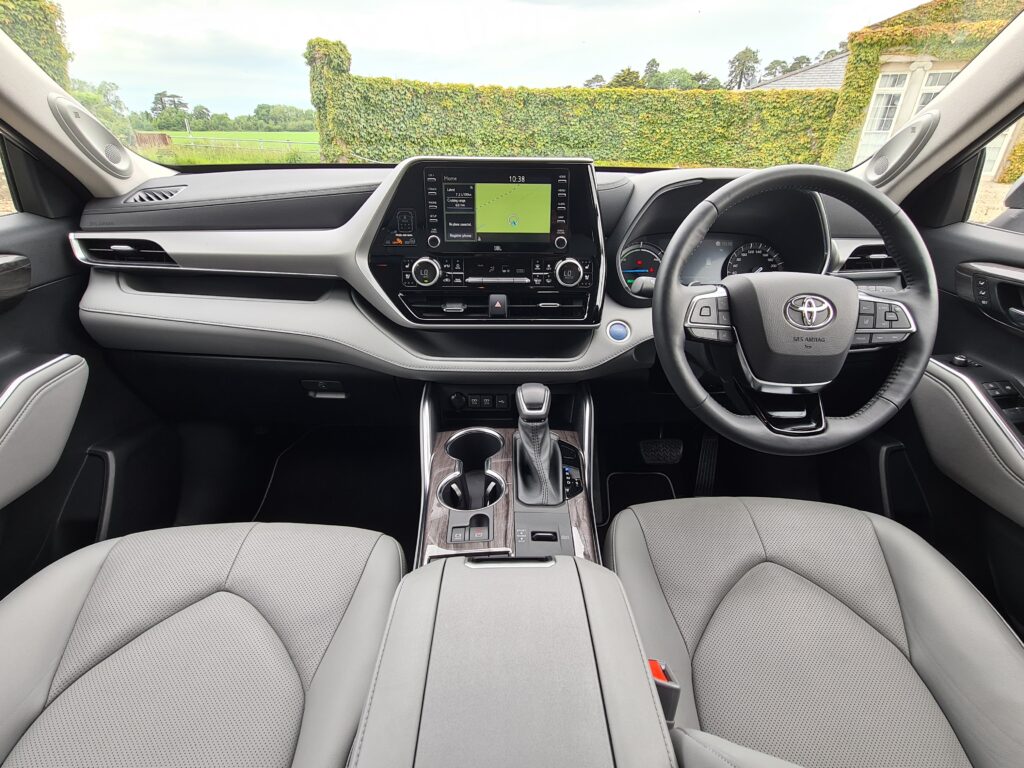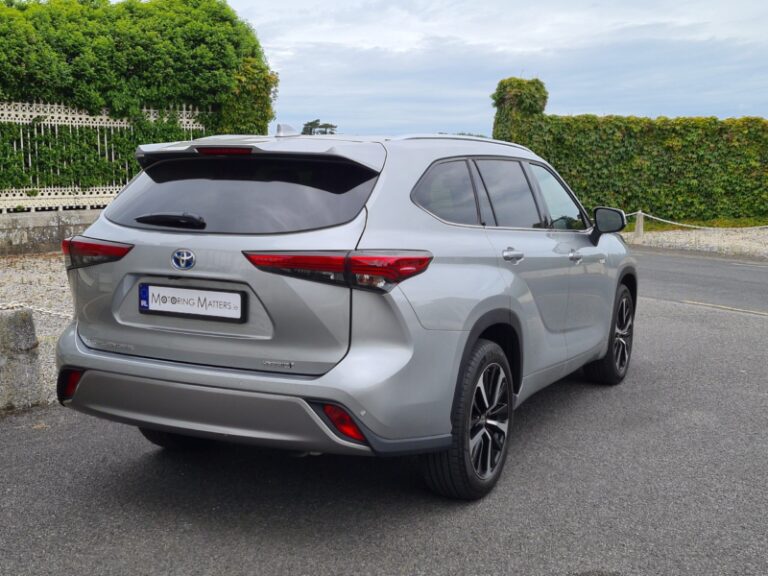By Breda Corrigan

The new Toyota Highlander is a large, seven-seat SUV that sits above the RAV4 in Toyota’s impressive SUV line-up, and is only offered as a petrol/electric hybrid. Rivals to the Highlander include the Kia Sorento and Hyundai Santa Fe, but Toyota feel that the Highlander is good enough to take on basic versions of the Audi Q7 and Land Rover Discovery too. The Highlander is a self-charging hybrid, and the system juggles between powering the wheels via petrol or electricity, and charging the small battery to always keep some electric power in reserve.

Outstanding Cabin & Boot Space.
Overall space within the cabin of the new Highlander is admirable to say the least, helped in no small part by an impressive 2,850mm wheelbase. Passengers seated in the middle row will benefit from generous legroom, especially with the sliding and reclining seats pushed all the way back, while headroom is excellent too. There is a flat floor through the centre of the vehicle, so all occupants will be able to enjoy the same level of comfort on every journey. As is normally the case in a seven-seat vehicle, the third row is best for kids, but will be also fine for adults on short journeys, and the rearmost seats are certainly more usable than those found in some competitors. The Highlander also has reclining seatbacks for the third row, and this will provide occupants of those seats with a greater level of comfort. Thanks to a super-easy tilt and slide function on the middle row of seats, gaining access to the rearmost seats is never an issue. With all seven seats in place, there is still enough room in the boot for the weekly grocery shopping. In five-seat guise, the Highlanders cargo capacity measures in at 658-litres, but this can be increased to a gigantic 1,909-litres when the seats in rows two and three are folded.

One Power Unit, Three Trims.
There is just one powertrain offering in the new Highlander, while three generously-specified trim grades are available. The sole engine is a 2.5-litre petrol unit with front and rear electric motors (providing all-wheel drive), and a powerful Nickel-Metal Hydride battery that is located under the middle row of seats. With a combined system output of 248bhp and 239Nm of torque, the Highlander can sprint from 0-100km/h in just 8.3-seconds (quite impressive for a vehicle weighing over two tonne), and is capable of consuming as little as 6.6-litres of petrol for every 100kms driven on a combined driving cycle (WLTP). A Drive Mode Select switch provides the driver with a choice of Eco, Normal, Sport and Trail drive modes to suit their individual driving style. All four drive modes may be used when the vehicle is operating in the separately-switchable EV mode. Buyers of the new Toyota Highlander can choose between entry-level Hybrid, mid-spec Sol, and top-spec Platinum trim grades, with all variants coming with a CVT automatic transmission as standard.
Functional & Practical Cabin.
The Toyota Highlander’s suspension set-up has been tuned in favour of comfort, and this will certainly please the vast majority of buyers in the full seven-seat SUV market. The relatively soft suspension irons out all but the worst potholes and speed ramps, and the laid-back feel from behind the steering wheel certainly will suit the sort of journeys that families are likely to be doing in a large SUV with seven seats. The functional and practical cabin in the Highlander comes equipped with a whole host of standard comfort, convenience, infotainment and safety features across all trim grades, with all occupants provided with great visibility no matter what seat they are in. Excellent build quality is evident everywhere throughout the Highlander’s cabin, and it certainly feels like this is a vehicle that will stand up well to everything a growing family can throw at it. All Highlander models get an 8-inch colour touchscreen infotainment system positioned on top of the centre console so that the driver’s eyes need to barely move in order to glance at it. Physical shortcut buttons positioned on either side of the touchscreen help you to skip from one key feature to another with the minimum of fuss, with Toyota’s voice command system providing additional help when requested. Both Apple CarPlay and Android Auto connectivity comes as standard, along with satellite navigation too.
Test Car Details.
My test car was a Toyota Highlander Platinum which was finished in Celestial Silver metallic paint with grey perforated leather upholstery featuring a diamond pattern and black stitching. Over and above the standard equipment tally across all models in the Highlander range, the main additions exclusively available in Platinum grade include: 20” machined-face alloy wheels, panoramic roof, Panoramic View Monitor (PVM), Head Up Display (HUD), powered tailgate door with kick function, smart interior mirror, heated and ventilated front seats, heated rear seats, and dark grey painted under-runs. With a platform and powertrain set-up modified from the RAV4, there are strong similarities between the RAV4 and the Highlander SUV’s from behind the wheel. Acceleration from a standing start is strong thanks to the subtle punch of the electric motor, so getting the Highlander up to speed doesn’t require a strong stomp of the accelerator. Once on the move, you can slip the Highlander into the EV mode via a button near the gear selector. This means that you can drive around city streets in silence, and at speeds of up to 60km/h before the petrol engine kicks in to assist the small battery. It will automatically slip into EV mode at cruising speed too, shutting down the engine for brief periods. The Highlander’s sporty steering set-up means that it is precise and easy to place on the road, defying its size in the process.
Verdict & Pricing.
With room for seven occupants and their luggage, along with lots of standard equipment, and a smooth, efficient hybrid powertrain, the new Toyota Highlander is a very commendable and competent large SUV, both on and off road. It has the power to cruise at speed on long motorway road trips, but low Co2 emissions for inner-city traffic. Pricing starts at €71,305 with my test car specification priced at €83,300 (excluding dealer delivery and related charges).


